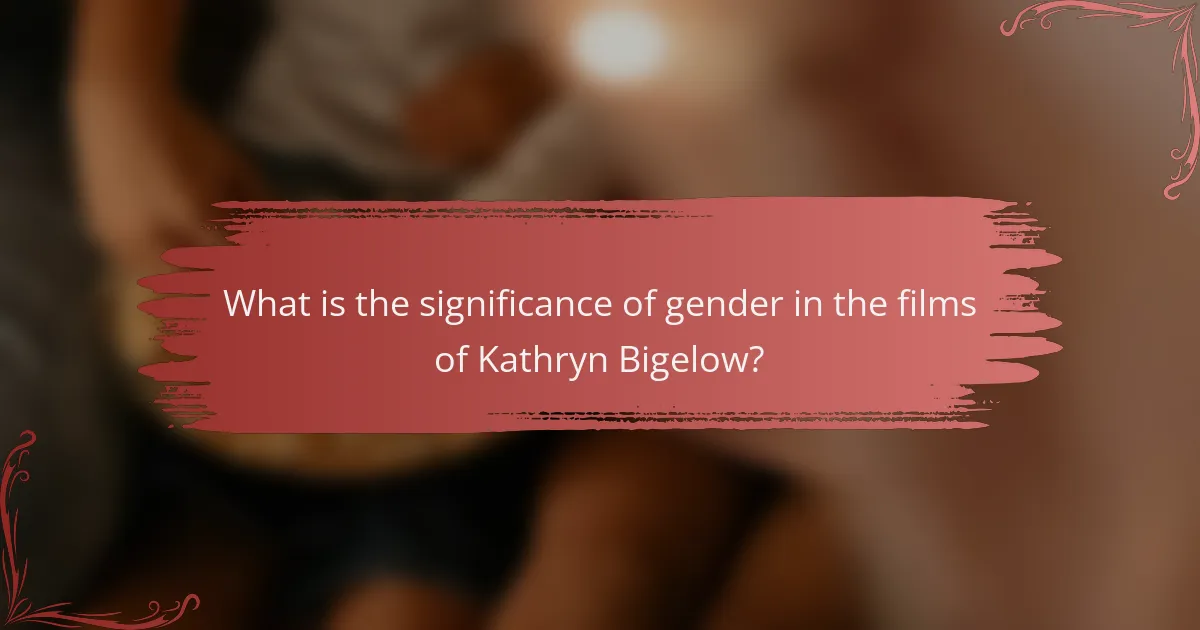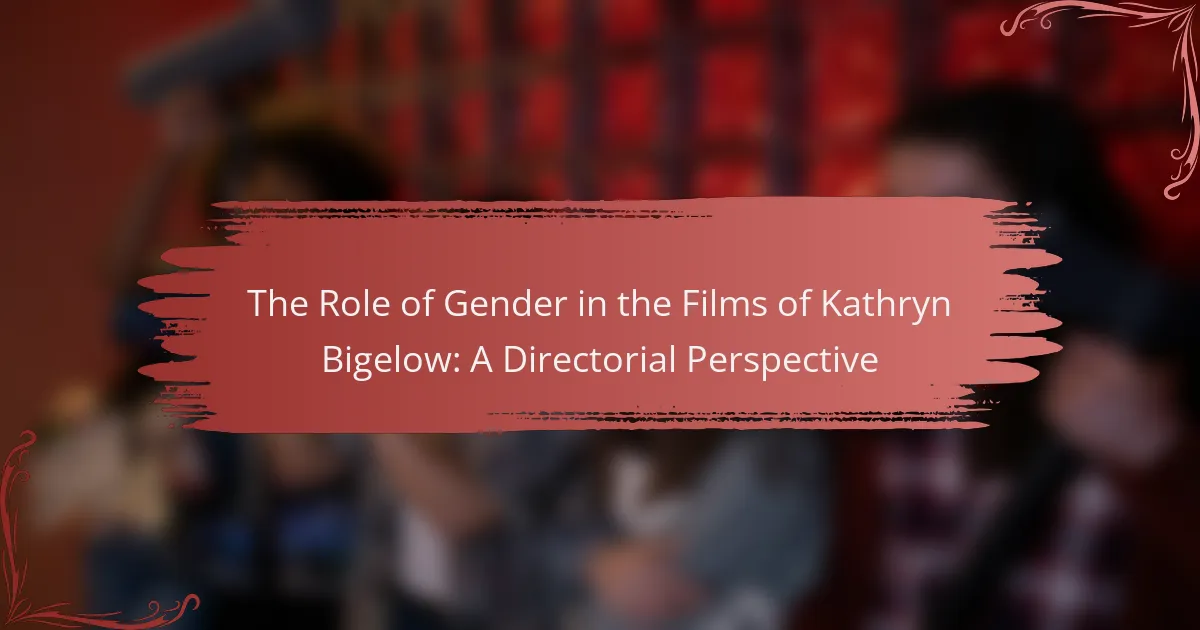The article examines the role of gender in the films of Kathryn Bigelow, a prominent director known for subverting traditional gender roles in cinema. Bigelow’s work features female characters in powerful and action-oriented roles, challenging stereotypes prevalent in the action genre. Notable films such as “Zero Dark Thirty” and “The Hurt Locker” illustrate her focus on complex narratives that explore gender dynamics and power structures. The article highlights Bigelow’s impact on gender representation in Hollywood, her achievements as a trailblazer for female filmmakers, and her contributions to discussions surrounding gender equality in the film industry.

What is the significance of gender in the films of Kathryn Bigelow?
The significance of gender in the films of Kathryn Bigelow lies in her subversion of traditional gender roles. Bigelow often portrays female characters in positions of power and agency. Her films challenge stereotypes by showcasing women in action-oriented roles. For instance, in “Zero Dark Thirty,” the lead character is a determined female intelligence officer. This representation contrasts with typical male-dominated narratives in the action genre. Bigelow’s work highlights the complexity of gender dynamics in high-stakes situations. Her approach invites audiences to reconsider societal expectations surrounding gender. Overall, Bigelow’s films contribute to broader discussions about gender representation in cinema.
How has Kathryn Bigelow’s directorial style influenced gender representation in her films?
Kathryn Bigelow’s directorial style has significantly influenced gender representation in her films by subverting traditional gender roles. She often portrays female characters in complex, powerful roles that defy stereotypes. For instance, in “Zero Dark Thirty,” the lead character, Maya, is depicted as a determined and skilled operative in a male-dominated environment. This challenges the conventional portrayal of women in action films. Bigelow’s use of a realistic, immersive filmmaking style further emphasizes the strength and capabilities of her female characters. Critics have noted that her films often present women as active agents rather than passive participants. This approach contributes to a more nuanced representation of gender in cinema. Overall, Bigelow’s work has reshaped narratives around female empowerment in the film industry.
What are the key characteristics of Bigelow’s directorial approach?
Kathryn Bigelow’s directorial approach is characterized by a focus on realism and intense emotional experiences. She often employs a visceral style that immerses viewers in the action. Bigelow frequently explores themes of masculinity and gender dynamics in her films. Her work showcases strong, complex female characters, challenging traditional gender roles. She utilizes innovative cinematography to enhance narrative tension. Bigelow’s films often feature a non-linear storytelling technique, creating suspense. She emphasizes authenticity through meticulous research and attention to detail in her settings. These characteristics contribute to her unique voice in contemporary cinema.
How does Bigelow’s style challenge traditional gender norms in cinema?
Kathryn Bigelow’s style challenges traditional gender norms in cinema by subverting typical gender roles. She often places women in positions of power and agency, defying the stereotype of female passivity. In films like “Zero Dark Thirty,” the lead character is a determined woman in a male-dominated environment. Bigelow’s direction emphasizes action and intensity, traits traditionally associated with masculinity. Her focus on realism and psychological depth showcases female characters as complex and multifaceted. This approach contrasts with the often superficial portrayals of women in mainstream cinema. Bigelow’s work has received critical acclaim, highlighting her impact on gender representation. Her films encourage a reevaluation of gender dynamics in action and thriller genres.
Why is Kathryn Bigelow considered a pioneering figure in gender representation?
Kathryn Bigelow is considered a pioneering figure in gender representation due to her groundbreaking approach to storytelling and character development. She is the first woman to win the Academy Award for Best Director for her film “The Hurt Locker” in 2010. Bigelow’s films often feature strong, complex female characters in traditionally male-dominated genres, such as action and war. Her work challenges gender stereotypes by portraying women as capable leaders and warriors. For instance, in “Zero Dark Thirty,” she presents a female protagonist who is integral to the mission, showcasing female strength and resilience. Bigelow’s unique perspective has opened doors for other female filmmakers and has influenced the portrayal of women in cinema.
What milestones has Bigelow achieved as a female director?
Kathryn Bigelow has achieved several significant milestones as a female director. She became the first woman to win the Academy Award for Best Director in 2010 for her film “The Hurt Locker.” This film also won six Oscars, highlighting her success in a male-dominated industry. Bigelow’s “Zero Dark Thirty” received five Academy Award nominations in 2013, further establishing her reputation. She is known for directing action films that challenge gender stereotypes. Bigelow has been recognized in various film festivals, including winning the Best Director award at the Venice Film Festival. Her work has paved the way for future female filmmakers in Hollywood.
How do her films compare to those of her male contemporaries in terms of gender portrayal?
Kathryn Bigelow’s films often present more nuanced and complex portrayals of gender compared to her male contemporaries. Her works frequently challenge traditional gender roles. For instance, in “Zero Dark Thirty,” the female protagonist is depicted as a strong and capable leader. This contrasts with many male-directed films that often reinforce stereotypical male dominance. Additionally, Bigelow’s focus on female agency is evident in “The Hurt Locker,” where female characters are portrayed with depth and complexity. Research indicates that films by female directors, including Bigelow, tend to have more multidimensional female characters. This pattern highlights a significant distinction in gender portrayal between her films and those directed by males.

How do specific films by Kathryn Bigelow explore gender themes?
Kathryn Bigelow’s films explore gender themes through complex characterizations and narrative choices. In “The Hurt Locker,” she portrays a female character in a traditionally male-dominated military setting. This challenges stereotypes about gender roles in warfare. “Zero Dark Thirty” features a strong female lead, Maya, who drives the narrative and decision-making processes. This representation highlights women’s capabilities in high-stakes environments. Bigelow’s use of tension and conflict often emphasizes the struggles women face in male-centric worlds. Her films reflect on the intersection of gender and power dynamics. By placing female characters in pivotal roles, Bigelow critiques societal expectations. Overall, her work invites viewers to reconsider traditional gender narratives.
What are the central gender themes in “The Hurt Locker”?
The central gender themes in “The Hurt Locker” include masculinity, gender roles, and the impact of war on identity. The film portrays male soldiers in high-stress situations, emphasizing traditional masculine traits such as bravery and stoicism. It challenges conventional gender norms by depicting vulnerability among male characters. The film also explores the emotional toll of war, affecting male soldiers’ relationships and sense of self. Kathryn Bigelow’s direction highlights the psychological aspects of masculinity in combat. This nuanced portrayal invites viewers to reconsider the implications of gender in warfare.
How does the film portray masculinity in the context of war?
The film portrays masculinity in the context of war as a complex interplay of vulnerability and aggression. Characters often embody traditional masculine traits such as strength and stoicism. However, the narrative also reveals their emotional struggles and moral dilemmas. For example, the protagonist faces intense psychological pressure, showcasing the toll of warfare on mental health. This duality emphasizes that masculinity is not solely about toughness. The film critiques the societal expectations placed on men in combat. It highlights the consequences of adhering to rigid masculine ideals. This portrayal challenges the glorification of war and prompts viewers to reconsider the definition of masculinity.
What role do female characters play in “The Hurt Locker”?
Female characters in “The Hurt Locker” primarily serve as symbols of the emotional and relational aspects of war. They are depicted through brief interactions, highlighting the personal lives of male soldiers. The protagonist’s wife appears in phone calls, emphasizing the strain of separation. This portrayal suggests the impact of war on family dynamics. Additionally, the presence of female characters underscores the gender roles within a male-dominated military environment. Their limited roles reflect societal expectations of women during wartime. Overall, female characters contribute to the narrative by illustrating the emotional consequences of conflict on relationships.
How does “Zero Dark Thirty” address gender dynamics?
“Zero Dark Thirty” addresses gender dynamics by presenting a female protagonist in a predominantly male environment. Maya, portrayed by Jessica Chastain, is a CIA analyst who navigates challenges in a male-dominated field. Her character defies traditional gender roles typically seen in action films. The film showcases her determination and intelligence as key to the mission’s success. Maya’s interactions with male colleagues highlight both support and tension related to gender. The portrayal of her character challenges stereotypes about women’s capabilities in high-stakes situations. Additionally, the film reflects on the broader implications of gender in military and intelligence operations. Overall, “Zero Dark Thirty” uses Maya’s character to explore the complexities of gender dynamics in a critical narrative context.
What is the significance of Jessica Chastain’s character in the film?
Jessica Chastain’s character is significant as she embodies a strong, complex female lead in a male-dominated narrative. Her role challenges traditional gender norms within the context of the film. Chastain’s character displays resilience, intelligence, and emotional depth. This representation highlights the capabilities of women in high-stakes environments. Furthermore, her character’s journey reflects the struggles and triumphs faced by women in positions of power. The film uses her character to critique gender stereotypes prevalent in the industry. Overall, Chastain’s portrayal serves as a pivotal element in advancing the narrative and exploring themes of gender dynamics.
How does the film depict the intersection of gender and power?
The film depicts the intersection of gender and power through its portrayal of female characters in dominant roles. These characters challenge traditional gender norms and assert their authority in male-dominated environments. For instance, the protagonist often displays leadership qualities that subvert typical gender expectations. The narrative emphasizes the complexities of power dynamics between genders, showcasing both empowerment and vulnerability. Additionally, the film highlights the societal obstacles women face while striving for power. This nuanced representation invites viewers to reconsider established gender roles in the context of authority and influence.

What impact has Kathryn Bigelow had on the film industry regarding gender issues?
Kathryn Bigelow has significantly impacted the film industry by challenging gender norms. She became the first woman to win an Academy Award for Best Director in 2010 for “The Hurt Locker.” This achievement highlighted the underrepresentation of women in directing roles. Bigelow’s films often feature strong female characters in non-traditional roles. Her work defies stereotypes typically associated with women in action films. She emphasizes complex narratives that explore themes of power and violence. Bigelow’s success has inspired a new generation of female filmmakers. Her influence encourages conversations about gender equality in Hollywood.
How has Bigelow influenced the representation of women in action films?
Kathryn Bigelow has significantly influenced the representation of women in action films. She presents female characters as complex and capable protagonists. Bigelow’s films often depict women in roles traditionally reserved for men. For instance, in “Zero Dark Thirty,” the lead character is a determined CIA agent. This portrayal challenges stereotypes about women in military and intelligence roles. Bigelow’s work emphasizes strength, resilience, and intelligence in female characters. Her direction has paved the way for more nuanced female roles in the action genre. This shift has inspired other filmmakers to create strong female leads. Overall, Bigelow’s contributions have redefined the narrative possibilities for women in action films.
What changes in the industry can be attributed to her work?
Kathryn Bigelow’s work has led to significant changes in the film industry. She became the first woman to win an Academy Award for Best Director in 2010 for “The Hurt Locker.” This achievement challenged the male-dominated perception of directorial roles. Her films often feature strong female characters, shifting industry norms regarding gender representation. Bigelow’s approach to action films has also redefined genre expectations, blending traditionally masculine themes with nuanced storytelling. Her success has inspired a new generation of female filmmakers to pursue careers in directing. This influence is evident in the increasing number of women directing major films since her breakthrough.
How do audiences perceive gender roles in action films after Bigelow’s contributions?
Audiences perceive gender roles in action films as more nuanced and complex after Kathryn Bigelow’s contributions. Bigelow’s films, such as “The Hurt Locker” and “Zero Dark Thirty,” feature strong female protagonists in traditionally male-dominated narratives. This shift challenges the stereotype of women as mere side characters or love interests. Viewers recognize that female characters can exhibit agency, resilience, and leadership. Studies indicate that Bigelow’s work has influenced other filmmakers to portray women in more empowered roles. Overall, her contributions have led to a broader acceptance of diverse gender representations in action cinema.
What can filmmakers learn from Kathryn Bigelow’s approach to gender representation?
Filmmakers can learn the importance of authentic character development from Kathryn Bigelow’s approach to gender representation. Bigelow creates multifaceted female characters who defy stereotypes. Her films often portray women in roles traditionally held by men, showcasing their strength and complexity. For example, in “Zero Dark Thirty,” the protagonist is a determined female CIA officer driving the narrative. This challenges conventional gender norms in action films. Furthermore, Bigelow’s focus on realism allows for a more nuanced exploration of gender dynamics. By prioritizing character depth over tokenism, filmmakers can create more compelling narratives. This approach can lead to a broader audience appeal and critical acclaim.
What best practices can be derived from her films for future directors?
Future directors can derive several best practices from Kathryn Bigelow’s films. Bigelow emphasizes the importance of strong character development. Her films often feature complex, multidimensional characters that resonate with audiences. She showcases the significance of authentic storytelling. Bigelow’s narratives are grounded in real-world issues, making them relatable and impactful.
Collaboration is another key practice. Bigelow frequently collaborates with talented cinematographers and production teams to enhance her vision. She demonstrates the value of meticulous research. Her attention to detail in depicting military and action sequences adds credibility to her work.
Additionally, Bigelow’s films often challenge gender stereotypes. She presents female characters in powerful roles, breaking traditional molds. This approach encourages future directors to create diverse representations in their storytelling. Lastly, her mastery of tension and pacing is noteworthy. Bigelow skillfully builds suspense, keeping audiences engaged throughout her films.
How can understanding gender dynamics enhance storytelling in film?
Understanding gender dynamics can enhance storytelling in film by providing deeper character development and more relatable narratives. Gender dynamics influence how characters interact and how their roles are perceived by audiences. Films that accurately portray these dynamics can reflect societal issues and provoke thought. For instance, Kathryn Bigelow’s films often challenge traditional gender roles, creating complex female characters. This approach can lead to more engaging and authentic stories. Research shows that films with diverse gender representation perform better both critically and commercially. Thus, understanding gender dynamics is crucial for impactful storytelling in contemporary cinema.
The main entity of the article is Kathryn Bigelow, a pioneering filmmaker known for her significant contributions to gender representation in cinema. The article examines the role of gender in Bigelow’s films, highlighting her subversion of traditional gender roles by portraying strong female characters in action-oriented narratives, such as “Zero Dark Thirty” and “The Hurt Locker.” It discusses her directorial style, which emphasizes realism and complex character development, and how her work challenges stereotypes and encourages a reevaluation of gender dynamics in film. Additionally, the article outlines Bigelow’s impact on the film industry and the lessons future filmmakers can learn from her approach to gender representation.
